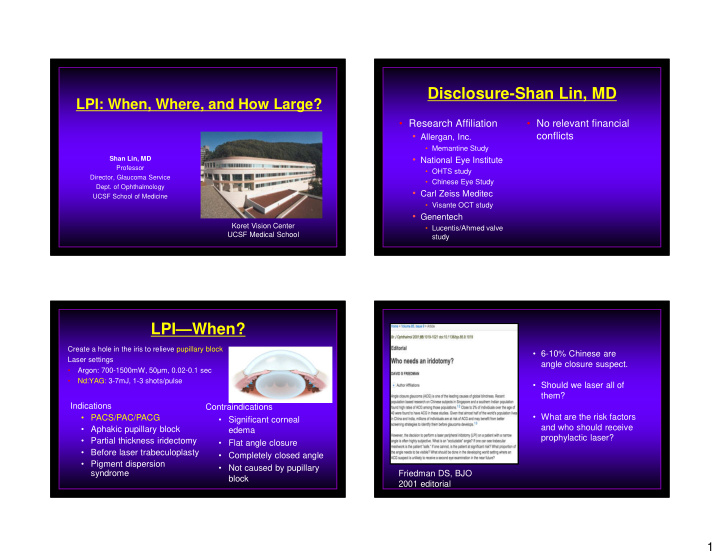



Disclosure-Shan Lin, MD LPI: When, Where, and How Large? • Research Affiliation • No relevant financial conflicts • Allergan, Inc. • Memantine Study • National Eye Institute Shan Lin, MD Professor • OHTS study Director, Glaucoma Service • Chinese Eye Study Dept. of Ophthalmology • Carl Zeiss Meditec UCSF School of Medicine • Visante OCT study • Genentech Koret Vision Center • Lucentis/Ahmed valve UCSF Medical School study LPI—When? Create a hole in the iris to relieve pupillary block • 6-10% Chinese are Laser settings angle closure suspect. • Argon: 700-1500mW, 50 µ m, 0.02-0.1 sec • Nd:YAG: 3-7mJ, 1-3 shots/pulse • Should we laser all of them? Indications Contraindications • What are the risk factors • PACS/PAC/PACG • Significant corneal and who should receive • Aphakic pupillary block edema prophylactic laser? • Partial thickness iridectomy • Flat angle closure • Before laser trabeculoplasty • Completely closed angle • Pigment dispersion • Not caused by pupillary syndrome Friedman DS, BJO block 2001 editorial 1
Risk gradient of angle closure Laser Iridotomy—When (Narrow angle to angle closure) Fellow eyes of acute attack • Pupillary block • At least half of fellow eye will develop acute attack in 5 years • Considered first line Rx [Lowe RF 1962, Snow JT, 1977] From occludable angles to primary angle closure • Other mechanisms (eg, Plateau iris) • 16% in 10 years develop acute or appositional closure • LPI still considered first line Rx to remove (Alsbirk 1992, Eskimos) • 22% in 5 years (Thomas 2003, Indians) pupillary block component • 17.3% in 4 years (Baskaran 2015, Singaporeans) • 20.4% in 6 years (Yip 2008, Mongolians) • Indication: ≥ 180 degrees grade 0-1 angle • 6% in a mean of 2.7 years (Wilensky 1993, Caucasians) 20% do not respond to prophylactic LPI Laser Iridotomy—Efficacy Who will likely NOT respond to LPI? • Smaller AOD (0.052mm remain close VS 0.108mm open) • Progression of ACG forms after LPI • More anterior iris insertion (SS-IR: 0.085 vs 0.125mm) • PAC Suspect • Thicker peripheral iris (0.447 vs 0.415 mm) • 22% � PAC • More CB anterior rotation (TCPD: 0.514 vs 0.562mm) • 4% � PAC Glaucoma • PAC • 5% � PAC Glaucoma • Cataract Surgery was significant factor in reducing risk for PACS progression He M Ophthalmology 2007 Peng P…Lin S. Br J Ophthalmol. 2011 Sep;95(9):1207-11. 2
Laser Iridotomy—Where, How Large? • Recommendations • Horizontal position • 217 subjects with superior LPI vs 250 controls • Objective glare measurement • Less photopsias • Cortical cataract is the only predictor for straylight score (Beta=0.04, P<0.01) • Avoid if ≥ 180 degrees of PAS • Not associated with • Risk for IOP spike and persistent IOP elevation – Age, sex – Presenting VA, Nuclear / subcapsular cataract grade • Large iridotomy – Size of LPI: vertical / horizontal diameter, circumference, area • Need more than just patent PI – Lid coverage: fully covered / partially covered / totally uncovered – Location: LPI distance to pupil center / lid margin / limbus, clock hour – Iris color Ophthalmology 2012;119(7):1375–1382 • New Linear dysphotopsia Light redirected superiorly strikes the superior Light passing through the temporal iris in a • Superior LPI (10.7%) > Temporal LPI (2.4%) (P<0.001) peripheral retina after a relatively short path, and straight path to strike the temporal posterior remains relatively focused pole, creating a defocused image • All of the superior LPI cases occurred in either fully or partially covered • Partially or completely covered LPIs > completely exposed LPIs. • Pain The tear film forms a triangular lake • Temporal LPI resulted in 1.5 times more pain than the superior LPI. at both the upper and lower lid margin, which can act as a base-up • Visual symptoms were not associated with the color of the iris. prism for incumbent light Vera et al. AJO 2014 Vera et al. AJO 2014 3
Nanophthalmos Case Nanophthalmos Case Right Eye Left Eye Right Eye Left Eye LPI Enlargement PRE POST • What is a patent LPI? • 150-200 um traditionally • Theoretical factors • Bochmann et al., 2008 • Case series (6) • Assess angle parameters after LPI Grade I enlargement Grade III Bochmann et al. Klin Monatsbl Augenheilkd 2008;225:349–352 4
Summary PRE • LPI—first line of defense • WHEN? • Occludable angles • Contralateral eyes of Acute ACG • Closed angle cases unless angle mostly closed • WHERE? POST • Horizontal • HOW LARGE? • More than 150 microns 5
Recommend
More recommend